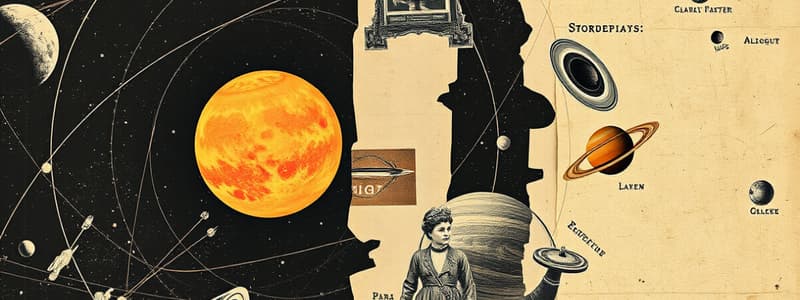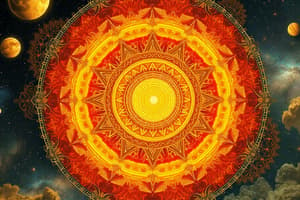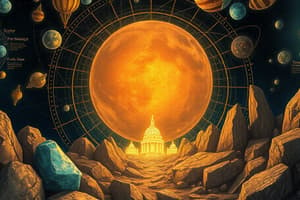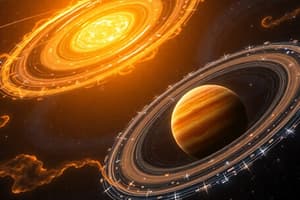Podcast
Questions and Answers
In the Solar Nebular Disc Model, planets orbit the sun along the same ______.
In the Solar Nebular Disc Model, planets orbit the sun along the same ______.
plane
The disc shape of our solar system is explained by the ______ hypothesis.
The disc shape of our solar system is explained by the ______ hypothesis.
Nebular
The ______ theory suggests that a pile of space dust and rock chunks formed our planet.
The ______ theory suggests that a pile of space dust and rock chunks formed our planet.
Accretion
A star is born when interstellar clouds, called ______, contract under gravity.
A star is born when interstellar clouds, called ______, contract under gravity.
The rotation of the mass in a nebula arranges the material into the shape of a flat ______.
The rotation of the mass in a nebula arranges the material into the shape of a flat ______.
The core of a protostar must be hotter than ______ million K for nuclear fusion to occur.
The core of a protostar must be hotter than ______ million K for nuclear fusion to occur.
As more materials accumulate in the core, it emits ultraviolet radiation due to increased ______ temperature.
As more materials accumulate in the core, it emits ultraviolet radiation due to increased ______ temperature.
The core of a protostar ignites and begins to emit ______.
The core of a protostar ignites and begins to emit ______.
Fusion happens when sub atomic particles collide at high speed to form a new atomic ______.
Fusion happens when sub atomic particles collide at high speed to form a new atomic ______.
If the core temperature of a protostar does not attain a temperature higher than 10 million K, it becomes a ‘______ dwarf’ or ‘failed star’.
If the core temperature of a protostar does not attain a temperature higher than 10 million K, it becomes a ‘______ dwarf’ or ‘failed star’.
Stars twinkle in ______ have the highest temperature.
Stars twinkle in ______ have the highest temperature.
The gaseous core of stars are exhaustible and will eventually collapse and begin to ______.
The gaseous core of stars are exhaustible and will eventually collapse and begin to ______.
Collapsing stars whose cores are three or more times larger than the mass of our Sun can form a ______.
Collapsing stars whose cores are three or more times larger than the mass of our Sun can form a ______.
The ______ clouds where our sun was formed collided with a supernova.
The ______ clouds where our sun was formed collided with a supernova.
When a temperature of 10 million K is reached, nuclear ______ occurs, powering up the formation of stable and heavy elements.
When a temperature of 10 million K is reached, nuclear ______ occurs, powering up the formation of stable and heavy elements.
The ______ hypothesis suggests that hydrogen and other gases swirled around and condensed into our sun and its planets.
The ______ hypothesis suggests that hydrogen and other gases swirled around and condensed into our sun and its planets.
The formation of the protosun and the protoplanets happened over a time span of at least ______ million years.
The formation of the protosun and the protoplanets happened over a time span of at least ______ million years.
The Solar Nebular Disc Model predicts the formation of a nebular disc made up of accreted gas and ______ clouds around the protosun.
The Solar Nebular Disc Model predicts the formation of a nebular disc made up of accreted gas and ______ clouds around the protosun.
The ______ theory explains how planets formed from the collision and condensation of materials in space.
The ______ theory explains how planets formed from the collision and condensation of materials in space.
The nebular hypothesis was originally proposed by ______ in 1755.
The nebular hypothesis was originally proposed by ______ in 1755.
Victor Sergeevich ______ contributed to the Solar Nebular Disc Model.
Victor Sergeevich ______ contributed to the Solar Nebular Disc Model.
The theory associated with the formation of celestial objects from interstellar ______ is key to understanding star birth.
The theory associated with the formation of celestial objects from interstellar ______ is key to understanding star birth.
The eventual discovery of the gas and dust ______ validated the Solar Nebular Disc Model.
The eventual discovery of the gas and dust ______ validated the Solar Nebular Disc Model.
The current accepted model for the formation of the solar system is based on the ______ theory and the properties of gas and dust.
The current accepted model for the formation of the solar system is based on the ______ theory and the properties of gas and dust.
Flashcards are hidden until you start studying
Study Notes
Solar System Structure
- The solar system has a disc shape where planets orbit the sun along a shared plane.
- Planets rotate in the same direction as their orbit around the sun.
Asteroid Belt
- Located between Mars and Jupiter, containing numerous rocky fragments.
Kuiper Belt and Oort Cloud
- Regions beyond Neptune filled with icy bodies and potential comets.
Theories of Solar System Origin
- Fission Theory: Suggests the Sun burst, ejecting planets and moons which then entered stable orbits.
- Capture Theory: Proposes that wandering objects were captured by the Sun's gravity.
- Accretion Theory: States that space dust and rock gradually formed planets and moons.
- Planetary Collision Theory: Suggests the Moon formed from debris due to a collision with a small planet.
- Stellar Collision Theory: Claims planets and moons originated from stellar collisions.
- Gas Cloud Theory: Proposes that gas clouds were captured by the Sun and formed planets through rotation.
Birth of Stars
- Stars form from interstellar clouds (nebulae) that contract due to gravity and start rotating.
- Dense materials in the core ignite, leading to the formation of a protostar.
Key Stellar Concepts
- Main sequence stars require a core temperature of over 10 million K for nuclear fusion.
- Stars below this temperature become "brown dwarfs" or "failed stars."
- Color indicators of temperature: blue stars are hottest; red stars are coolest.
Star Lifecycle
- Stars burn gaseous cores until elements are exhausted, leading to core collapse and death.
- Supernovae result from collapsing stars, with cores three times the Sun's mass forming black holes.
Formation of the Sun
- The Sun formed from a solar nebula undergoing a supernova collision, concentrating gas and dust into the center.
- Temperature increases due to collisions led to ignition and brightening of the clouds.
Formation of Planets
- At 10 million K, nuclear fusion produces heavy elements necessary for forming protoplanets.
- The formation process lasted approximately 100 million years.
Astronomy Overview
- Astronomy studies celestial objects and phenomena beyond Earth's atmosphere, including stars, galaxies, and cosmic events.
Early Theories of Solar System Origin
- Initial accounts of solar system formation were based on myths and legends.
- Early scientific theories proposed gas cloud collisions or condensations as mechanisms for formation.
Nebular Hypothesis
- Initial Theory: Proposed by Immanuel Kant and expanded by Pierre Simon Laplace, suggesting gases condensed into the sun and planets.
- Modern Variation: The Solar Nebular Disc Model (SNDM) developed by Victor Sergeevich Safranov, showing a nebular disc from which planets formed.
- The validation of the gas and dust cloud formation supports this current model of solar system origin.
Studying That Suits You
Use AI to generate personalized quizzes and flashcards to suit your learning preferences.




